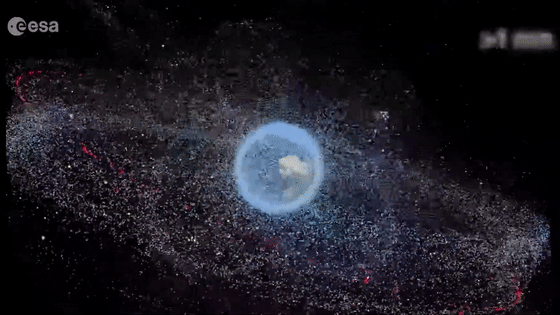Over 1 million satellites could be headed to Earth orbit, and scientists are worried
Rwanda's 337,320-satellite constellation, Cinnamon-937, is the single largest megaconstellation on the books.

Earth's lower orbit, already crowded with tens of thousands of satellites, may soon choke with many more, underscoring a need for stringent laws regarding the use of shared orbital space, according to new research.
More specifically, experts believe more than a million satellites are headed to low-Earth orbit. To arrive at that figure, researchers studied recent filings in the International Telecommunication Union (ITU) database, which is a United Nations agency responsible for granting spaces in orbit for satellite use. To launch and operate satellite populations, nations are required to submit relevant information to the ITU.
The records show nations worldwide have proposed launching over a million satellites distributed across 300 "megaconstellations," which are vast networks of satellites that work together to provide internet services. The proposed satellites are 115 times higher than the number of functional satellites currently circling Earth, the new study finds.
"If even a portion of these million satellites are actually launched, national and international rules will be needed to address the associated sustainability challenges, like collision risks, light pollution, and reentry risks," Andrew Falle, a researcher at the University of British Columbia's Outer Space Institute and lead author of the new study, told Space.com.
Related: The BlueWalker 3 satellite is officially one of the brightest objects in the sky
Filings between 2017 and 2022 in the ITU's database show nations have filed for satellite groups much larger than SpaceX's Starlink, which remains the biggest satellite megaconstellation in space to date and has nearly 5,000 components with more to come.
Rwanda's Cinnamon-937 satellite constellation, for instance, is currently the single biggest constellation filed with the ITU and projects a total of 337,320 components. When Falle and his team noticed this filing, they began looking through others. Sure enough, they kept finding similar large constellations from companies based all around the world including in China, Germany, Spain, Norway, France and Solomon Islands.
Get the Space.com Newsletter
Breaking space news, the latest updates on rocket launches, skywatching events and more!
"But it wasn't just the big numbers that interested us," Ewan Wright, a graduate student at the University of British Columbia and co-author of the new study, told Space.com. "The more we looked into the issues around these constellations the more we saw that the ITU would struggle to keep up."
The new analysis also highlights a bigger concern: The large amount of filings in ITU's database may indicate governments or companies are applying for orbital space for a much higher number of satellites than they intend to actually launch.
This is partly to capitalize on varying regulations among nations and minimize oversight; it appears that companies are filing for the same constellation through different nations. For instance, Norway, Germany and the United States registered licenses for SpaceX, while OneWeb's filings were registered similarly by the U.K., France and Mexico, the new study finds. On Oct. 11, SpaceX for the first time filed with the ITU through the Kingdom of Tonga for a constellation of 29,988 satellites.
Moreover, many of the proposed satellites may never be launched due to funding problems, changes in political support or engineering or technology issues, researchers say. Nevertheless, the evidence of overfiling is a dire warning that humanity is creating safety and sustainability challenges to use the seemingly unlimited orbital space.
There is at least one major opportunity available to mitigate it, researchers say. This year's World Radiocommunication Conference, which is being held in late November in Dubai, is where ITU's 193 member states and spectrum regulators review and revise radio regulations.
To tackle growing concerns with a cluttered orbital space, in 2019 the ITU introduced milestones for satellite constellations that companies must meet to preserve their rights to orbital spots. The rules require companies to launch 10 percent of their satellite constellation within two years of the first satellite, fifty percent within 5 years and the full constellation by year seven.
"This is a welcome development, but that first satellite can be launched up to 7 years from the initial filing — so it could be a decade before we know which constellations are realistic," Falle told Space.com.
This year's conference aims to tackle some of the challenges associated with satellite megaconstellations, the researchers write in the study. They outline a few potential solutions, including limits on the number of satellites in each constellation, higher fees for larger filings, and possibly, "bonds" that could be repaid once satellites are deorbited.
If the filings were limited in some manner, "the ITU would have more realistic projections on how many satellites will actually launch or can fit into certain orbits," Wright told Space.com, "this would help reduce the issues around projected — and actual — radio frequency interference, as well as the potential environmental problems."
Ultimately, the researchers say the ITU's authority over the radio spectrum makes it uniquely capable of managing the increasingly crowded environment in low-Earth orbit, which is "a finite resource that belongs — and should remain accessible — to all humankind."
The study is described in a paper published Thursday (Oct. 12) in the journal Science.
Join our Space Forums to keep talking space on the latest missions, night sky and more! And if you have a news tip, correction or comment, let us know at: community@space.com.

Sharmila Kuthunur is a Seattle-based science journalist focusing on astronomy and space exploration. Her work has also appeared in Scientific American, Astronomy and Live Science, among other publications. She has earned a master's degree in journalism from Northeastern University in Boston. Follow her on BlueSky @skuthunur.bsky.social









